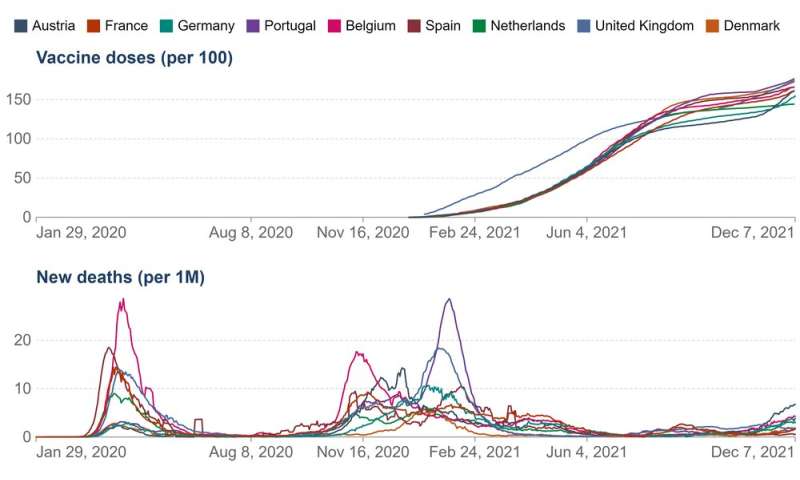Vaccines are necessary, but not sufficient without better healthcare and ventilation

A high vaccination rate is the foundation of any pandemic policy, but further protection is still needed. From an economic perspective, that protection comes from more investment in healthcare and air quality, which now seem essential complements to vaccines and face masks.
Looking at continental Europe over the last weeks, it seems the relative calm of the vaccine summer is over. The vaccines work wonderfully but are not a miracle cure. Austria is a painful example, where vaccination rates are low in mountainous areas (63% of total population), but much higher around Vienna (70%). And just as doctors in rural Salzburg were deciding between life and death three weeks ago, the situation got out of hand in Vienna as well. This culminated into a national lockdown, 2020 style.
Daily new confirmed COVID cases per million people
The reason is simple. The vaccines protect us against hospitalization and severe disease (see graph below), but less against transmission with each month that goes by. Hence the term vaccine waning. As a result, the virus can still circulate in places with high vaccination rates, and crucially, pressure on hospitals can rise rapidly since vaccinated people still have a small risk of ending up there. A small percentage of a very large group is all it takes.
COVID-19 doses and confirmed deaths
This pressure cooker would have been a lot more explosive without the vaccines, and we can be grateful for that, but it shows the limitations of a strategy solely based on vaccination. This goes for Western Europe, but also for the UK where COVID numbers have stabilized at an uncomfortably high level and are creeping up again.
More importantly, even if boosters can provide more sustainable protection against transmission, which seems increasingly likely, there is no guarantee this will also cover the latest Omicron variant. And adapting the vaccines to new variants takes 100 days at best.
Given this uncertainty, and to minimize the risk of further lockdowns which come with huge societal and economic costs, having a broader long-term strategy as we move from pandemic to endemic phase (the normal circulation of a virus, like flu) cannot hurt.
https://youtube.com/watch?v=p0tCPwyJ6JI%3Fcolor%3Dwhite
Increasing efforts
So what can be done? Besides getting that third shot into as many arms as possible, we can first of all boost healthcare itself. Since the crisis could last for years and we do not know what other crises lie ahead, this can be seen as a valuable insurance.
In the Netherlands for example, vaccination coverage is as high as in Belgium (75% of total population) but ICU capacity is lower (and only slightly lower than in the UK), which partially explains why Belgium was able to avoid a stricter lockdown last month.
Such a safety net then consists primarily of sufficient ICU, acute care, vaccination and testing capacity, but certainly also of more support for GPs and long-term care, since everything is connected.
As much of the current pressure on healthcare systems is due to absenteeism, protecting the mental health of healthcare workers and giving them a pay raise would be a quick win. Making lateral-flow tests freely and widely available across Europe to boost testing capacity, as the UK has done, is another. All in all, boosting healthcare can be seen as a productive investment, as it gives us more of a buffer before having to shut down schools or parts of the economy.
Subsidies to improve air quality could be a second strategy. Why not make this compulsory for all large office buildings and schools, and organize checks on CO₂ meters in the hospitality industry, for example? We have known for more than a year that the virus is also spread through the air—especially in enclosed spaces where the aerosol cloud can build up, just like cigarette smoke. So places need to be well ventilated. A recent study shows that indoor CO₂ monitoring reveals to be a practical proxy to SARS-CoV-2 transmission risk.
Better ventilation and air filters are a logical solution. Working with air filters is surprisingly cheap and flexible, and is a quick fix, while refitting existing buildings with better ventilation is more cumbersome and costly.

But even this would be a clear win in the long run, since studies show that well-ventilated spaces make for a better learning environment or workplace. Better air means fewer respiratory illnesses in general, so this investment would also increase our productivity in normal times.
Given that these are all productive investments, we can use our remaining fiscal flexibility to finance them. The benefits will outweigh the costs, which are still peanuts compared to the huge sums of state aid given to companies in the form of grants and loans during the pandemic, partially propping up “zombie companies.” The latter was a necessary evil, a side effect from saving entire economies from the brink in 2020-2021. But now the time has come to gradually phase out this support, and invest in strategies for the future.
Working from home
But even if we go for all those investments, we are not out of the woods yet. To fully eliminate the lockdown risk, we need to be able to switch up remote working relatively quickly. If the figures rise above a certain level, remote working could become the norm.
Experts will have to decide on the thresholds, and which jobs will qualify, but the principle is clear. When we are on the brink, we work from home as much as possible. Even when this causes efficiency losses, which is far from certain if we pick the right jobs, it must be clear to employers that the alternative of a lockdown is much worse. Unfortunately, we cannot continue paying for furlough schemes and state aid should something similar happen in future.
Source: Read Full Article
